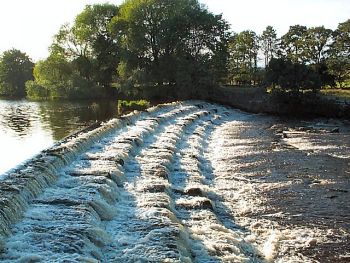Weir Flow: Difference between revisions
No edit summary |
|||
| (5 intermediate revisions by 3 users not shown) | |||
| Line 8: | Line 8: | ||
{{Picture | {{Picture | ||
<!-- Add image file name (ex.image.jpg) --> | <!-- Add image file name (ex.image.jpg) --> | ||
|image= | |image= Stepped_Weir_UK.jpg | ||
<!--Add link if applicable --> | <!--Add link if applicable --> | ||
|link= | |link= | ||
<!-- Add picture caption --> | <!-- Add picture caption --> | ||
|caption= This stepped weir is a run-of-river structure that acts as a low-head dam. | |caption= This stepped weir is a run-of-river structure that acts as a low-head dam. | ||
(Image Source: [https://www.geograph.org.uk/photo/55998 David Spencer]) | |||
}} | }} | ||
<!-- Introductory paragraph or topic page summary --> | <!-- Introductory paragraph or topic page summary --> | ||
[[Weirs]] are used to control the flow of water at dams and are typically uncontrolled, meaning that there are no gates that control the flow over the weir. Weirs can either consist of the entire dam structure, such as in the case of run-of-river low-head dams (see example photo above), or are only placed on top of the dam and are the beginning of the spillway structure. | [[Weirs]] are used to control the flow of water at dams and are typically uncontrolled, meaning that there are no gates that control the flow over the weir (also see [[Spillway Control Structures]]). Weirs can either consist of the entire dam structure, such as in the case of run-of-river low-head dams (see example photo above), or are only placed on top of the dam and are the beginning of the spillway structure. | ||
== The Weir Equation == | == The Weir Equation == | ||
| Line 36: | Line 37: | ||
* [[Ogee Crest Weirs]] | * [[Ogee Crest Weirs]] | ||
* [[Sharp-Crested Weirs]] | * [[Sharp-Crested Weirs]] | ||
* [[Labyrinth Spillways | Labyrinth Weirs]] | * [[Labyrinth Spillways | Labyrinth Weirs]] | ||
* [[Piano Key Weirs]] | * [[Piano Key Spillways | Piano Key Weirs]] | ||
<!-- == Examples == --> | <!-- == Examples == --> | ||
== Best Practices Resources == | == Best Practices Resources == | ||
{{Document Icon}} [[Hydraulic Design of Spillways (EM 1110-2-1603) | Hydraulic Design of Spillways (EM 1110-2-1603), USACE | {{Document Icon}} [[Hydraulic Design of Spillways (EM 1110-2-1603) | Hydraulic Design of Spillways (EM 1110-2-1603), USACE]] | ||
{{Document Icon}} [[Discharge Characteristics of Broad-Crested Weirs (GSC-397) | Discharge Characteristics of Broad-Crested Weirs (GSC-397), USGS | {{Document Icon}} [[Discharge Characteristics of Broad-Crested Weirs (GSC-397) | Discharge Characteristics of Broad-Crested Weirs (GSC-397), USGS]] | ||
== Trainings == | == Trainings == | ||
Latest revision as of 23:17, 28 September 2023

|
| This stepped weir is a run-of-river structure that acts as a low-head dam.
(Image Source: David Spencer) |
Weirs are used to control the flow of water at dams and are typically uncontrolled, meaning that there are no gates that control the flow over the weir (also see Spillway Control Structures). Weirs can either consist of the entire dam structure, such as in the case of run-of-river low-head dams (see example photo above), or are only placed on top of the dam and are the beginning of the spillway structure.
The Weir Equation
Weirs typically force lower specific energy subcritical flow approaching from upstream to pass through critical depth over the crest of the weir and results in higher specific energy supercritical flow downstream of the weir. The governing equation to calculate flow over the crest of a weir is the following: [1]
Q = C * L * H1.5
Where Q equals flow in cubic feet per second, L equals crest length perpendicular to the flow path, H equals the elevation of the hydraulic grade line above the weir crest, and C equals a discharge coefficient specific to the type weir crest or shape.
Crest Shape, Weir Footprint Shape, and Discharge Coefficients
Crest shape is important as it affects the discharge coefficient used in the weir equation. Higher efficiency crest shapes, such as ogee shapes result in higher discharge coefficients, while lower efficiency shapes, such as broad-crested weirs result in lower discharge coefficients.
Weirs can have both linear and non-linear footprints such as bent or arch-shaped weirs or labyrinth weirs. In addition to the crest shape, these different footprint shapes can also have effects on the discharge coefficient of a weir. Therefore considerations for both of these factors is important when using data to calculate the discharge coefficient used in weir calculations.
Types of Weirs
Best Practices Resources
![]() Hydraulic Design of Spillways (EM 1110-2-1603), USACE
Hydraulic Design of Spillways (EM 1110-2-1603), USACE
![]() Discharge Characteristics of Broad-Crested Weirs (GSC-397), USGS
Discharge Characteristics of Broad-Crested Weirs (GSC-397), USGS
Trainings
![]() On-Demand Webinar: Dam Safety with 3D Weirs, ASDSO, 2016
On-Demand Webinar: Dam Safety with 3D Weirs, ASDSO, 2016
![]() On-Demand Webinar: Hydraulic Design of Labyrinth Weirs, ASDSO, 2013
On-Demand Webinar: Hydraulic Design of Labyrinth Weirs, ASDSO, 2013
Citations:
Revision ID: 7706
Revision Date: 09/28/2023
